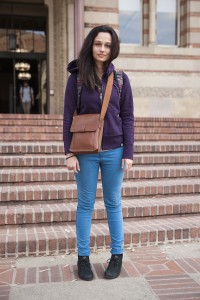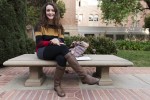The fashion industry is one that constantly evolves and pushes different boundaries every day. On the personal level, the world of fashion is also open to interpretation, giving individuals a chance to reflect their personal style. Columnists Alexis Williams and Aubrey Yeo look at different topics in fashion and find out what keeps fashion moving forward at UCLA. This week, they will focus on the influence of New York Fashion Week’s motif of color-blocking, as seen on campus.
The cover of the 1965 September issue of the French Vogue Magazine showcased a dress from Yves Saint Laurent that would end up becoming one of the most iconic dresses in modern fashion.
Inspired and named after the Dutch painter Piet Mondrian, Saint Laurent’s Mondrian day dress – which now resides in the Metropolitan Museum of Art – features big blocks of red, yellow and blue outlined by black on a white dress. The then-avant-garde concept of transforming fine art pieces into something wearable wasn’t the only novel aspect of the dress, however. The Mondrian day dress also introduced the concept of introducing multiple colors in a single outfit during an era when the popular opinion was to pair a single color with neutrals.

What once began with a blend of bright primary colors has now been adapted in several forms on campus even with less eye-catching shades.
“I like to go for more autumn colors, which is why fall and winter (are) the best time to color-block for me,” said first-year psychobiology student Karli Ashjian. “Mostly I just wear dresses that incorporate multiple colors.”
Over in the world of high fashion, color-blocking has popped up in the latest designs of the various collections paraded at the 2015 Mercedes-Benz New York Fashion Week that took place this past week.
A dress by EDUN – a fashion label started by U2 frontman Bono and his wife Ali Hewson – showcases the the pattern’s timeless appeal. Its influence from Saint Laurent’s creation can be seen through the similar use of color-blocking and design.
The concept of color-blocking has, however, also seen an evolution by way of different interpretations since its inception in the 60s. A Delpozo outfit that graced the runway during New York Fashion Week demonstrates how the concept can be incorporated into layering, as the outfit consists of a pink knit pinafore dress over a yellow turtleneck sweater. On the other hand, the football-themed green Tommy Hilfiger dress displays how color-blocking can be integrated with the seams of clothes through its use of yellow sleeves to create a look that reappropriates the letterman jacket for high fashion.
When it comes to color-blocking for myself, my clothing of choice happens to be a red and blue cardigan. But really, you shouldn’t block out any color combination.
– Aubrey Yeo
***
I was always told bright colors like pink and green, purple and red or blue and yellow can’t be worn together.
And then I saw Dsquared2’s Spring/Summer 2015 runway show at Milan Fashion week.
The label’s two designers, identical twin brothers from Canada, never fail to dazzle their audiences with their runway shows – the label’s hockey-themed Autumn/Winter 2010-2011 menswear runway show featured blood-stained, black-eyed and bruised models.
But this past September in Milan, the brothers decided on comparatively simple themes for both men’s and women’s shows and let their bold colors speak for themselves. And according to Dsquared2, pink and green can and should be worn together.
The show used bright neons to highlight color-blocking, the pairing of solid colors, together in one look, either by wearing one piece with multiple blocks of color, or by pairing separate solids. Although the trend has been around for decades, it was heavily stressed in the Spring/Summer 2015 shows back in September.
Though the twins emphasized pairing bright colors on opposite sides of the color wheel, designer Lucas Nascimento highlighted another way of color-blocking – pairing monochromatic shades in the same outfit.
Graduate film student Gayatri Bajpai took her color-blocked look in Dsquared2’s direction, pairing two completely different separate solids together and forming one cohesive look.
Like myself, Bajpai said she tends to stick to black and neutrals for her everyday looks, but that branching out has earned her lots of attention.
“A lot of people have been commenting on how brightly I dress these days,” Bajpai said. “It’s a nice change. I got really bored of the black, gray and brown.”
When I color-block, I like to keep things simple and pattern-free too, using bright colors to emphasize the trend. The easiest way to achieve the look is with one piece that features several colors on its own, like the color block bandage dress by Herve Leger. The label creates color-block dresses in various styles and colors, but in each style the colors are separated by black, giving the dress a timeless, almost artistic, feel.
However, my favorite way to color-block is with solid separates, the brighter the better. While black will always be my go-to color, there’s something about pairing bright orange shorts with a hot pink blouse that just feels like spring. The key to color-blocking an entire outfit is to pick separates that are simple, yet have structure on their own.
– Alexis Williams
